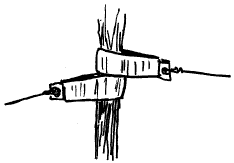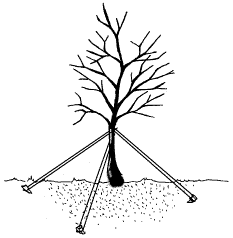Staking Trees
Staking trees can be a controversial subject. There is so much information out there about the right way, and the wrong way to stake a tree.
What are the reasons why you should stake a tree?
How should you stake a tree that needs to be staked?
This how-to mini module is designed to help the do-it-yourselfer understand just that.
The information in this module is a combination of experience, research, and cross referencing of different methods, to make sure you are not doing it the wrong way.
Our goal at Dream-yard is to give you the information, tips, and techniques, so you can complete your landscaping projects like a professional.
We encourage other professionals in the industry to write in to us with their tips and techniques, so we can always be improving this site for everyone's benefit. There are new studies and methods on how to stake a tree brought forth every year, and staying on top of these can be a challenge.
If you happen to stumble on a new method, product, or article, please share the information with us so we can review it and add it if we feel it has value.
I came up with the best analogy I could when it comes to how and why to stake a tree. Think of tree staking as training wheels for your tree. If it doesn't need them, don't put them on.
Have you ever seen training wheels touching the ground when someone is riding along just fine? The wheels are just off the ground, and only there for a guide. This gives the rider a chance to compensate before falling.
Just like some children have a natural strength and balance, some trees also have a good balance of roots, to the canopy they are supporting. If your tree is in a well protected area from wind and it is not top heavy, then don't stake the tree. It will develop a strong root system on its own.
If you feel the tree is top heavy, tall, and may be exposed to strong winds, then you should stake the tree loosely to protect it from heavy winds or imbalanced weight.
If you are ever in doubt, check with your local nursery as to what they recommend. The nursery is usually the one that is going to warranty your purchase.
Stake tree methods
There are different ways to stake a tree properly, and also different products available for staking. Most landscape centers, seasonal departments, or garden sections sell tree staking kits that come with directions. Like all products, some are better than others. Some products actually don't touch the tree, but rather stabilize the root ball itself.
For most trees, use at least two stakes unless the tree is less than 6 ft.(In this case it is acceptable to use only one stake.) Have 1 stake on the side of your prevailing winds.(This is the direction that the wind most often comes from).
Drive the stakes into the ground away from the root ball so you don't damage any roots. Make sure the stakes are set lower than any of the lower branches, so they don't rub against each other on windy days.

If the tree has a small root ball, is top heavy, or has unstable soil, drive the stakes in the ground so they are vertical. Tie off the tree loosely with soft fabric straps or wire through a rubber hose leaving it a tiny bit of room to sway. Studies have shown that this slight movement will strengthen the roots.(see diagram.)
If the tree is rather large, or may be exposed to strong winds, you can stake the tree with the three stake method.(Guying) Drive the stakes into the ground at an inward angle, and not into the root ball. Two of the stakes can be placed so the prevailing winds split the stake placement down the middle. This ensures that you won't have excessive rubbing at one particular spot.
Prevailing winds will always vary a few degrees. Place the third stake balanced with these two on the opposite side. These stakes should be lower than the vertical stakes. (see diagram)

To prevent damaging the roots when driving stakes into the ground, you can put the stakes in first. If you do, be careful to leave enough room for the root ball to pass through the stakes into the hole.
After you have staked the tree, don't just leave it on it's own. Check the tree periodically where you have it tied. Make sure there are no signs of excessive rubbing, or cutting into the trunk. Make sure that the stakes have not worked themselves loose.
If you have a windy day, check the tree and stakes for stability as soon as possible. You invested time and money into your tree so take care of it.
Make sure you remove the stakes after the first growing season. The sooner you can remove the stakes, the better off the tree will be. You will have to test it first to see if it is ready.
Before you remove the stakes test the tree by gently rocking it back and forth. If you see a lot of movement in the root ball it may need another season of staking. This simple test allows you to be sure the tree is ready to have it's training wheels removed.
Acknowledgement: The Team at Dream-yard, would like to thank our friends at North Dakota State University for their permission to use the diagrams posted with this Mini-Module on Tree Staking.
NDSU, Department of Plant Sciences, Agriculture and University Extension
______________________________________
Return from STAKING TREES to THE YARD: HOW-TO MODULES
Go to the Dream Yard Home Page
Check out our time and money saving e-book
How to avoid the biggest mistakes made by DIYers, designers, and landscaping companies.
Visitor
Favorites
Giggles 'n' Thoughts





